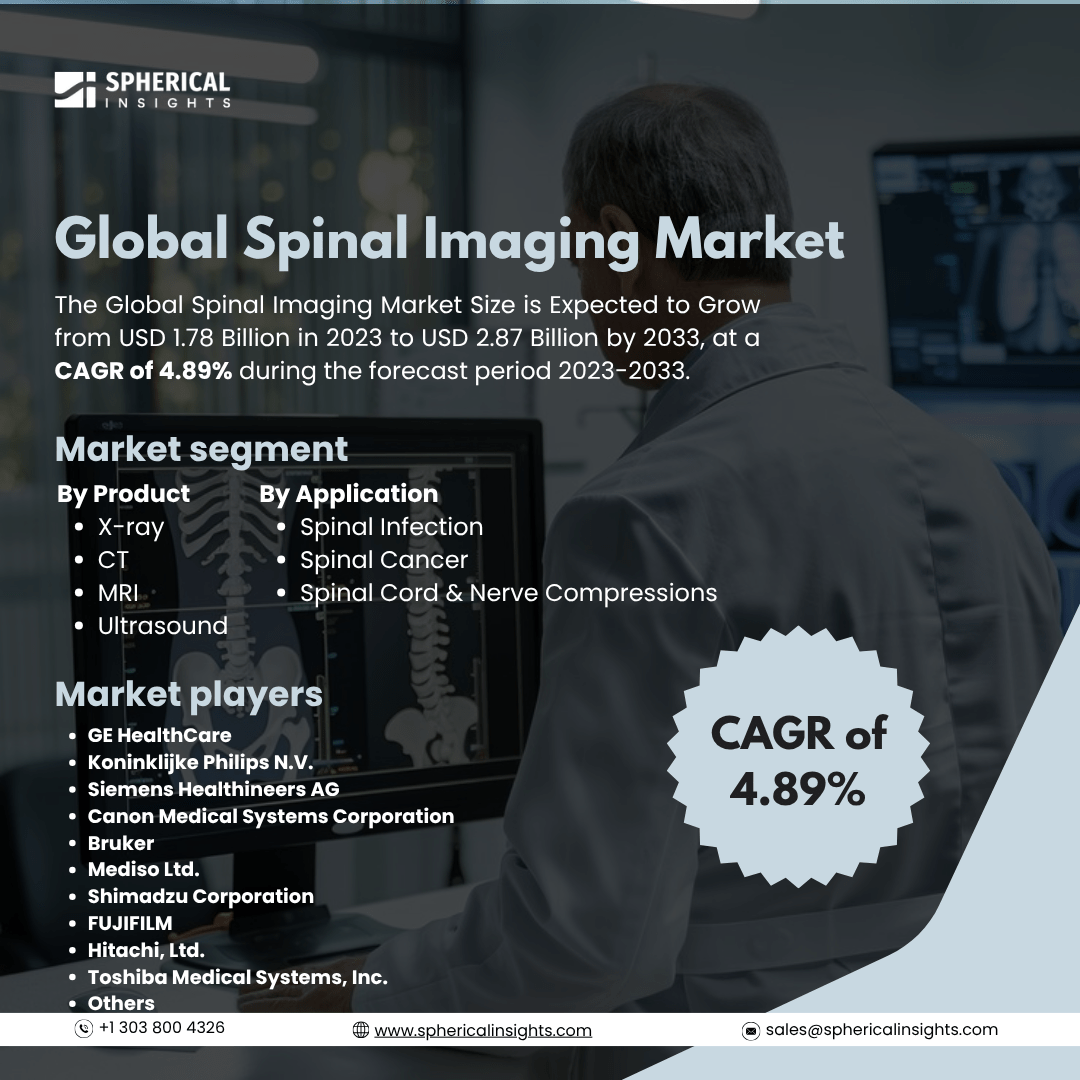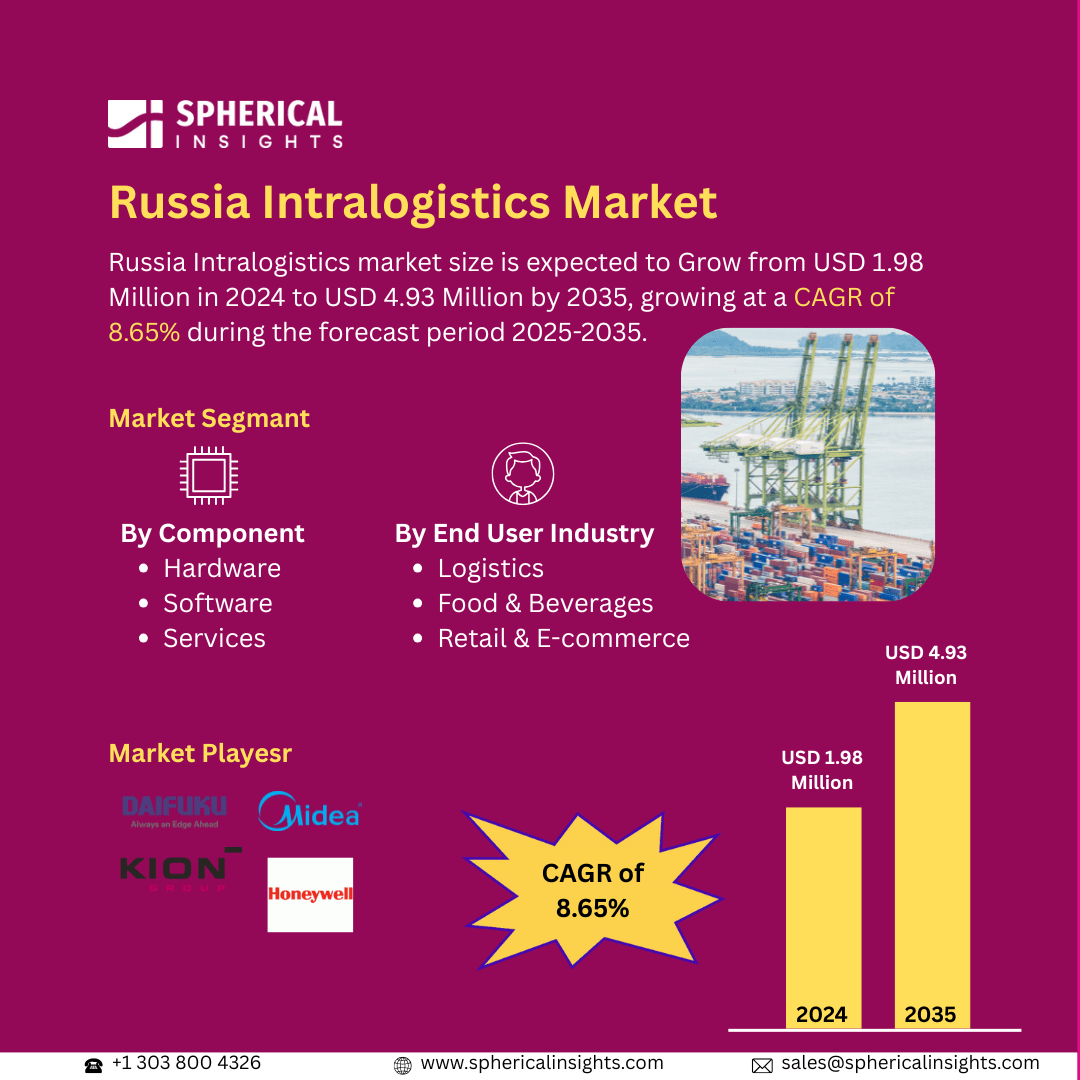Global Spinal Imaging Market Size To Exceed USD 2.87 Billion By 2033
According to a research report published by Spherical Insights & Consulting, The Global Spinal Imaging Market Size is Expected to Grow from USD 1.78 Billion in 2023 to USD 2.87 Billion by 2033, at a CAGR of 4.89% during the forecast period 2023-2033.
Browse 210 Market Data Tables And 45 Figures Spread Through 190 Pages and In-Depth TOC On The Global Spinal Imaging Market Size, Share, and COVID-19 Impact Analysis, By Product (X-ray, CT, MRI and Ultrasound), By Application (Spinal Infection, Spinal Cancer and Spinal Cord & Nerve Compressions), and By Region (North America, Europe, Asia-Pacific, Latin America, Middle East, and Africa), Analysis and Forecast 2023 - 2033.
The spinal imaging market comprises the diagnostics and therapy services used to examine spinal problems, using technologies like MRI, CT scans, and X-rays. Its main objective is to detect disorders such as fractures, malignancies, spinal stenosis, and herniated discs. Spinal imaging is the process of producing fine-grained images of the spine, spinal cord, and surrounding tissues using medical imaging techniques. Furthermore, the demand for spine imaging equipment is also expected to increase due to a sedentary lifestyle, an aging population, and rising rates of obesity, anxiety, and depression. As time passes, the intervertebral discs degrade, making people more vulnerable to spinal problems. The increasing number of spinal illnesses worldwide, the ease with which patients may access medical imaging services, and the increasing number of spinal surgeries performed are expected to fuel product demand. The WHO reports that upper respiratory infections are the most common reason for medical consultations, with lower back discomfort coming in second. However, Strict regulatory frameworks, accessibility problems, and expensive equipment are some of the obstacles facing the spinal imaging market.
The MRI segment dominated the largest share in 2023 and is anticipated to grow at a significant CAGR during the forecast period.
Based on the product, the global spinal imaging market is divided into x-ray, CT, MRI, and ultrasound. Among these, the MRI segment dominated the largest share in 2023 and is anticipated to grow at a significant CAGR during the forecast period. This is because it can produce high-resolution images without emitting ionizing radiation, which makes it a safer option than CT scans, especially for individuals who need imaging procedures frequently. Herniated discs, spinal stenosis, and infections can all be accurately identified because of MRI's exceptional soft tissue contrast, which enables thorough imaging of the spinal structures, intervertebral discs, and surrounding tissues.
The spinal cord & nerve compressions segment held the highest share in 2023 and is anticipated to grow at a significant CAGR during the forecast period.
Based on the application, the global spinal imaging market is divided into spinal infection, spinal cancer, spinal cord & nerve compressions. Among these, the spinal cord & nerve compressions segment held the highest share in 2023 and is anticipated to grow at a significant CAGR during the forecast period. The segment's expansion is anticipated to be driven by the increasing prevalence of spinal illnesses, including radiculopathy, cauda equina syndrome, spinal stenosis, and herniated disc. This is due to its better soft-tissue imaging capabilities; magnetic resonance imaging (MRI) is the imaging modality of choice for diagnosing spinal nerve compression. Furthermore, one of the primary causes of spinal surgery is spinal cord compression, which raises the need for spinal imaging technologies.
North America is anticipated to hold the highest share of the global spinal imaging market over the projected period.
North America is anticipated to hold the highest share of the global spinal imaging market over the projected period. This is ascribed to a strong emphasis on patient well-being, a well-established healthcare system, cutting-edge imaging technology, and encouraging reimbursement policies. This is because of the high prevalence of spinal problems in the area brought on by things like aging populations and sedentary lifestyles, there is a steady need for spinal imaging services.
Asia Pacific is estimated to grow at the fastest CAGR in the global spinal imaging market during the forecast period. A growing population, rising healthcare costs, and more knowledge of spinal health issues are all contributing to the demand for better imaging technologies. Furthermore, the region's growing middle class is making high-quality healthcare, including specialized spinal imaging services, more accessible. The market expansion is also aided by constructive government initiatives, including supporting preventative healthcare measures and investing in healthcare infrastructure.
Company profiling
Major vendors in the global spinal imaging market are GE HealthCare, Koninklijke Philips N.V., Siemens Healthineers AG, Canon Medical Systems Corporation, Bruker, Mediso Ltd., Shimadzu Corporation, FUJIFILM, Hitachi, Ltd., Toshiba Medical Systems, Inc., and others.
Key Target Audience
- Market Players
- Investors
- End-users
- Government Authorities
- Consulting and Research Firm
- Venture capitalists
- Value-Added Resellers (VARs)
Market Segment
This study forecasts revenue at the global, regional, and country levels from 2023 to 2033. Spherical Insights has segmented the global spinal imaging market based on the below-mentioned segments:
Global Spinal Imaging Market, By Product
Global Spinal Imaging Market, By Application
- Spinal Infection
- Spinal Cancer
- Spinal Cord & Nerve Compressions
Global Spinal Imaging Market, By Regional
- North America
- Europe
- Germany
- UK
- France
- Italy
- Spain
- Russia
- Rest of Europe
- Asia Pacific
- China
- Japan
- India
- South Korea
- Australia
- Rest of Asia Pacific
- South America
- Brazil
- Argentina
- Rest of South America
- Middle East & Africa
- UAE
- Saudi Arabia
- Qatar
- South Africa
- Rest of the Middle East & Africa



